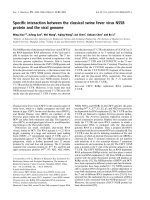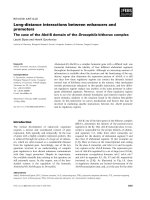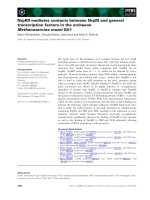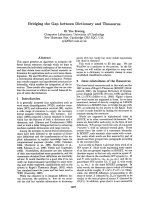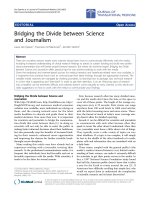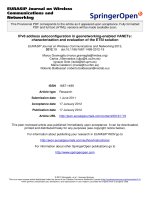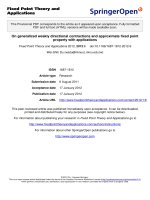Báo cáo toán học: " Music-aided affective interaction between human and service robot" pptx
Bạn đang xem bản rút gọn của tài liệu. Xem và tải ngay bản đầy đủ của tài liệu tại đây (9.1 MB, 44 trang )
EURASIP Journal on Audio,
Speech, and Music Processing
This Provisional PDF corresponds to the article as it appeared upon acceptance. Fully formatted
PDF and full text (HTML) versions will be made available soon.
Music-aided affective interaction between human and service robot
EURASIP Journal on Audio, Speech, and Music Processing 2012,
2012:5 doi:10.1186/1687-4722-2012-5
Jeong-Sik Park ()
Gil-Jin Jang ()
Yong-Ho Seo ()
ISSN
Article type
1687-4722
Research
Submission date
2 April 2011
Acceptance date
19 January 2012
Publication date
19 January 2012
Article URL
/>
This peer-reviewed article was published immediately upon acceptance. It can be downloaded,
printed and distributed freely for any purposes (see copyright notice below).
For information about publishing your research in EURASIP ASMP go to
/>For information about other SpringerOpen publications go to
© 2012 Park et al. ; licensee Springer.
This is an open access article distributed under the terms of the Creative Commons Attribution License ( />which permits unrestricted use, distribution, and reproduction in any medium, provided the original work is properly cited.
Music-aided affective interaction between human and service
robot
Jeong-Sik Park1, Gil-Jin Jang2 and Yong-Ho Seo*3
1
Computer Science Department, Korea Advanced Institute of Science and
Technology (KAIST), Daejeon, South Korea
2
School of Electrical and Computer Engineering, Ulsan National Institute of
Science and Technology (UNIST), Ulsan, South Korea
3
Department of Intelligent Robot Engineering, Mokwon University,
Daejeon, South Korea
*
Corresponding author:
Email addresses:
J-SP:
G-JJ:
Y-HS:
Abstract
This study proposes a music-aided framework for affective interaction of
service robots with humans. The framework consists of three systems,
respectively, for perception, memory, and expression on the basis of the
human brain mechanism. We propose a novel approach to identify human
emotions in the perception system. The conventional approaches use speech
and facial expressions as representative bimodal indicators for emotion
recognition. But, our approach uses the mood of music as a supplementary
indicator to more correctly determine emotions along with speech and facial
expressions. For multimodal emotion recognition, we propose an effective
decision criterion using records of bimodal recognition results relevant to
the musical mood. The memory and expression systems also utilize musical
data to provide natural and affective reactions to human emotions. For
evaluation of our approach, we simulated the proposed human–robot
interaction with a service robot, iRobiQ. Our perception system exhibited
superior performance over the conventional approach, and most human
participants noted favorable reactions toward the music-aided affective
interaction.
1.
Introduction
Service robots operate autonomously to provide useful services for humans.
Unlike industrial robots, service robots interact with a large number of users
in a variety of places from hospitals to home. As design and implementation
breakthroughs in the field of service, robotics follow one another rapidly,
people are beginning to take a great interest in these robots. An immense
variety of service robots are being developed to perform human tasks such
as educating children and assisting elderly people. In order to coexist in
humans’ daily life and offer services in accordance with a user’s intention,
service robots should be able to affectively interact and communicate with
humans.
Affective interaction provides robots with human-like capabilities for
comprehending the emotional states of users and interacting with them
accordingly. For example, if a robot detects a negative user emotion, it
might encourage or console the user by playing digital music or synthesized
speech and by performing controlled movements. Accordingly, the primary
task for affective interaction is to provide the robot with the capacity to
automatically recognize emotional states from human emotional information
and produce affective reactions relevant to user emotions.
Human emotional information can be obtained from various indicators:
speech, facial expressions, gestures, pulse rate, and so forth. Although many
researchers have tried to create an exact definition of emotions, the general
conclusion that has been drawn is that emotions are difficult to define and
understand [1, 2]. Because of this uncertainty in defining emotions,
identifying human emotional states via a single indicator is not an easy task
even for humans [3]. For this reason, researchers began to investigate
multimodal information processing, which uses two or more indicators
simultaneously to identify emotional states.
In the conventional approaches, speech and facial expression have
successfully been combined for multimodality, since they both directly
convey human emotions [4, 5]. Nevertheless, these indicators have several
disadvantages for service robots. First, users need to remain in front of the
robots while expressing emotions through either a microphone or a camera.
Once a user moves out of sight, the robot may fail to monitor the emotional
states. Second, the great variability in characteristics of speech or facial
expression with which humans express their emotions might deteriorate the
recognition accuracy. In general, different humans rarely express their
emotional states in the same way. Thus, some people who express emotions
with unusual characteristics may fail to achieve satisfactory performance on
standard emotion recognition systems [6].
To overcome these disadvantages of the conventional approaches, this
study proposes a music-aided affective interaction technique. Music is
oftentimes referred to as a language of emotion [7]. People commonly enjoy
listening to music that presents certain moods in accordance with their
emotions. In previous studies, researchers confirmed that music greatly
influences the affective and cognitive states of users [8–10]. For this reason,
we utilize the mood of music that a user is listening to, as a supplementary
indicator for affective interaction. Although the musical mood conveys the
emotional information of humans in an indirect manner, the variability of
emotional states that humans experience while listening to music is
relatively low, as compared with that of speech or facial expression.
Furthermore, the music-based approach has a smaller limitation with respect
to the distance between a user and a robot.
The remainder of this article is organized as follows. Section 2 reviews
previous studies that are relevant to this study. Section 3 proposes a
framework for affective interaction between humans and robots. Section 4
provides specific procedures of music-aided affective interaction. Section 5
explains the experimental setup and results. Finally, Section 6 presents our
conclusions.
2.
Previous studies on affective interaction between humans and
robots
An increasing awareness of the importance of emotions leads the
researchers to attempt to integrate affective computing into a variety of
products such as electronic games, toys, and software agents [11]. Many
researchers in robotics also have been exploring affective interaction
between humans and robots in order to accomplish the intended goal of
human–robot interaction.
For example, a sociable robot, ‘Kismet’, understands human intention
through facial expressions and engages in infant-like interactions with
human caregivers [12]. ‘AIBO’, an entertainment robot, behaves like a
friendly and life-like dog that responds to either the touch or sound of
humans [13]. A conversational robot called ‘Mel’ introduced a new
paradigm of service robots that leads human–robot interaction by
demonstrating practical knowledge [14]. A cat robot was designed to
simulate emotional behavior arising from physical interactions between a
human and a cat [15]. Tosa and Nakatsu [16, 17] have concentrated on the
technology of speech emotion recognition to develop speech-based robot
interaction. Their early studies, ‘MUSE’ and ‘MIC’, were capable of
recognizing human emotions from speech and expressing emotional states
through computer graphics on a screen. They have consistently advanced
their research directions and developed more applications.
3.
Framework for affective interaction
In efforts to satisfy the requirements for affective interaction, researchers
have explored and advanced various types of software functions.
Accordingly, it is necessary to integrate those functions and efficiently
manage systematic operations according to human intentions. The best
approach for this is to organize a control architecture or a framework for
affective interaction between a human and a robot.
Our research target is humanoid service robots that perform human-like
operations and behaviors. Thus, we propose a new framework based on a
model of the human brain structure developed by the cognitive scientist
Ledoux [18]. This framework consists of three individual systems associated
with one another, as demonstrated in Figure 1.
The primary function of the perception system is to obtain human
emotional information from the outside world through useful indicators such
as facial expression and speech. The memory system records the emotional
memories of users and corresponding information in order to utilize them
during the interaction with humans. Finally, the expression system executes
the behavior accordingly and expresses emotions of the robot.
4.
Music-aided affective interaction
In the conventional approaches to achieve affective interaction, both speech
and facial expression have mostly been used as representative indicators to
obtain human emotional information. Those indicators, however, have
several disadvantages when operated in robots, as addressed in Section 1. In
addition, most of the conventional approaches convey the robot’s emotional
states in monotonous ways, using a limited number of figures or synthesized
speech. Thus, users easily predict the robot’s reactions and can lose interest
in affective interaction with the robot. To overcome these drawbacks, we
adopt music information in the framework of affective interaction.
Music is an ideal cue for identifying the internal emotions of humans and
also has strong influences on the change of human emotion. Hence, we
strongly believe that music will enable robots to more naturally and
emotionally interact with humans. For the music-aided affective interaction,
the mood of the music is recognized in the perception system and is utilized
in the determination of the user’s emotional state. Furthermore, our
expression system produces affective reactions to the user emotions in more
natural ways by playing music that the robot recommends or songs that the
user previously listened to while exhibiting that emotion. The music-aided
affective reaction is directly supported by the memory system. This system
stores information on the music the user listens to with a particular
emotional state. This section describes further specific features of each
system in the framework of music-aided affective interaction.
4.1.
Perception system
The perception system recognizes human emotional states on the basis of
various indicators. For multimodal emotion recognition, the proposed
system utilizes the musical mood as a supplementary indicator along with
speech and facial expression as primary indicators. Consequently, the
perception system comprises three recognition modules: for musical mood,
facial expression, and speech emotion. Among them, modules based on face
and speech are jointly handled as bimodal emotion recognition in this study.
The overall process of this system is illustrated in Figure 2.
4.1.1. Musical mood recognition
One of the essential advantages of music-based emotion recognition is that
monitoring of human emotion can be accomplished in the background
without the user’s attention. Users do not need to remain in front of the
robot, since the musical sound can be loud enough to be analyzed in the
perception system. For this reason, the module of the musical mood
recognition is operated independently from the other modules in the
perception system. Even though the musical mood provides a conjectured
user emotion, the recognition result sufficiently enables the robot to
naturally proceed with affective and friendly interaction with the user as
long as the user plays music. For instance, if a user is listening to sad music,
the robot can express concern, using a display or sound.
Compared to other tasks for musical information retrieval, such as genre
identification, research on musical mood recognition is still in an early
stage. General approaches have concentrated on acoustic features
representing the musical mood and criteria for the classification of moods
[19–21]. A recent study focused on a context-based approach that uses
contextual information such as websites, tags, and lyrics [22]. In this study,
we attempt to identify the musical mood without consideration of contextual
information to extend the range of music to instrumental music such as
sound-tracks of films. Thus, we follow the general procedure of nonlinguistic information retrieval from speech or sound [23, 24].
The mood recognition module is activated when the perception system
detects musical signals. Audio signals transmitted through a microphone of
a robot can be either musical signals or human voice signals. Thus, the
audio signals need to be classified into music and voice, since the system is
programmed to process voice signals in the speech emotion recognition
module. For the classification of audio signals, we employ the standard
method of voice activity detection based on the zero crossing rate (ZCR)
and energy [25]. When the audio signals indicate relatively high values in
both ZCR and energy, the signals are regarded as musical signals.
Otherwise, the signals are categorized as voice signals and submitted to the
speech processing module.
The first step of the musical mood recognition is to extract acoustic
features representing the musical mood. Several studies have reported that
Mel-frequency cepstral coefficients (MFCC) provide reliable performance
on musical mood recognition, as this feature reflects the nonlinear frequency
sensitivity of the human auditory system [19, 20]. Linear prediction
coefficients (LPC) are also known as a useful feature that describes musical
characteristics well [23]. These two features are commonly used as shortterm acoustic features, non-linguistic characteristics of which are effectively
defined with probability density functions such as a Gaussian distribution
[26, 27]. For this reason, we use these features as primary features. After
extracting these features from each frame of 10–40 ms in music streams,
their first and second derivatives are added to the feature set of the
corresponding frame in order to consider temporal characteristics between
consecutive frames.
The next step is to estimate the log-likelihood of the features on respective
acoustic models constructed for each type of musical mood. Acoustic
models should hence be trained in advance of this step. In this study, the
distribution of acoustic features extracted from music data corresponding to
each mood is modeled by a Gaussian density function. Thus, a Gaussian
mixture model (GMM) is constructed for each musical mood in accordance
with model training procedures. The log-likelihood of feature vectors
extracted from given music signals is computed on each GMM, as follows:
T
r
log P( X | λi ) = ∑ log P( xt | λi ),
(1)
t =1
where
r
r
X ( = {x1 ,..., xT })
refers to a vector sequence of acoustic features that are
extracted from the music stream, and GMM
λi
(i = 1,…,M if there are M
musical moods) indicates the mood model. M log-likelihood results are then
submitted to the emotion decision process.
4.1.2. Bimodal emotion recognition from facial expression and speech
Facial expression and speech are the representative indicators that directly
convey human emotional information. Because those indicators provide
emotional information that is supplementary and/or complementary to each
other, they have successfully been combined in terms of bimodal indicators.
The bimodal emotion recognition approach integrates the recognition
results, respectively, obtained from face and speech.
In facial expression recognition, accurate detection of the face has an
important influence on the recognition performance. A bottom-up, featurebased approach is widely used for the robust face detection. This approach
searches an image through a set of facial features indicating color and shape,
and then groups them into face candidates based on the geometric
relationship of the facial features. Finally, a candidate region is decided as a
face by locating eyes in the eye region of a candidate’s face. The detected
facial image is submitted to the module for facial expression recognition.
The first step of facial expression recognition is to normalize the captured
image. Two kinds of features are then extracted on the basis of Ekman’s
facial expression features [28]. The first feature is a facial image consisting
of three facial regions: the lips, eyebrows, and forehead. By applying
histogram equalization and the threshold of the standard distribution of the
brightness of the normalized facial image, each of the facial regions is
extracted from the entire image. The second feature is an edge image of
those three facial regions. The edges around the regions are extracted by
using histogram equalization.
Next, the facial features are trained according to a specific classifier in order
to determine explicitly distinctive boundaries between emotions. The
boundary is used as a criterion to decide an emotional state for a given facial
image. Various techniques already in use for conventional pattern
classification problems are likewise used for such emotion classifiers.
Among them, neural network (NN)-based approaches have widely been
adopted for facial emotion recognition, and have provided reliable
performance [29–31]. A recent study on NN-based emotion recognition [32]
reported the efficiency of the back-propagation (BP) algorithm proposed by
Rumelhart and McClelland in 1986 [33]. In this study, we follow a training
procedure introduced in [31] that uses an advanced BP algorithm called
error BP.
Each of the extracted features is trained by using two neural networks for
each type of emotion. Each neural network is composed of 1610 input
nodes, 6 hidden nodes, and M output nodes. The 1610 input nodes receive
1610 pixels from the input image, and the output nodes, respectively,
correspond to each of M emotions. The number of hidden nodes was
determined by an experiment. Finally, the decision logic determines the
final emotion from the two neural network results. The face-emotion
decision logic utilizes the weighted sum of the two results and a voting
method of the result transitions over the time domain. The overall process of
emotion recognition through facial expression is shown in Figure 3.
Once audio signals transmitted through a robot microphone are
determined to be human voice signals, the speech emotion recognition
module is activated. In the first step, several acoustic features representing
emotional characteristics are estimated from the voice signals. Two types of
acoustic features are extracted: a phonetic feature and a prosodic feature.
MFCC and LPC pertaining to musical mood recognition are also employed
for speech emotion recognition in terms of phonetic features, while spectral
energy and pitch are used as prosodic features. As in musical mood
recognition, the first and second derivatives of all features are added to the
feature set.
Next, the acoustic features are recognized through a pattern classifier.
Even though various classifiers such as HMM and SVM have been fed into
speech emotion recognition tasks, we employ the neural network-based
classifier used in the facial expression recognition module in order to
efficiently handle the fusion process in which the recognition results of two
indicators are integrated. We organize a sub-neural network for each
emotion. The construction of each sub-network has basically the same
architecture. A sub-network comprises input nodes corresponding to the
dimension of the acoustic features, hidden nodes, and an output node. The
number of hidden nodes varies according to the distinctness of respective
emotions. When there are M emotions, acoustic features extracted from the
voice signals are simultaneously fed into M sub-networks, and thus an Mdimensional vector is obtained for the recognition result. The configuration
of the neural network is similar to that adopted in [17], but we adjust
internal learning weights of each sub-network and the normalization
algorithm in consideration of the characteristics of the acoustic features.
Figure 4 describes a simplified architecture for the proposed bimodal
recognition when the number of emotions is M. As a recognition result, an
M-dimensional vector is, respectively, obtained from facial expression and
speech. Let us denote Rface(t) and Rspeech(t) as the vectors obtained from the
two indicators at time t. The final procedure of the bimodal emotion
recognition is to perform a fusion process in which the results, Rface(t) and
Rspeech(t), are integrated. We calculate the vector Rbimodal(t) referred to as a
fusion vector, as follows:
Rbimodal(t) = WfRface(t) + WsRspeech(t) + WfRface(t – 1) + WsRspeech(t – 1)
(2)
where Wf and Ws are the weights for the respective indicators.
The weights are appropriately determined by reference to the recognition
results for each indicator.
In general, the performance of standard emotion recognition systems
substantially depends on the user characteristics in expressing emotional
states [6]. Thus, systems occasionally demonstrate the common error of a
rapid transition of human emotional states. To address this problem, we
consider the general tendency that human emotional states rarely change
quickly back and forth. Hence, the proposed fusion process in (2) uses two
recognition results obtained just before the current time t in order to reflect
the emotional state demonstrated during the previous time.
4.1.3. Emotion decision
The final procedure in the perception system is to determine an emotion on
the basis of the bimodal fusion vector calculated in (2) and the mood
recognition result estimated in (1). These two results indicate different
scales about the values but have the same dimension corresponding to the
number of emotions and moods. Let us denote Rbimodal(e) and Rmusic(e) as the
value of the eth emotion in the fusion vector and that of the eth mood in the
mood recognition result, respectively.
In addition to these two results, our decision mechanism utilizes
supplementary information. This research originated from the general idea
of the relationship between music and human emotion. We strongly believe
that the music that a person listens to directly correlates with the emotion
that the person feels. Thus, if a robot detects a musical mood similar to the
mood that a user has enjoyed in the past, the user would be in an emotional
state similar to the emotion the robot determined at that time. To consider
this aspect, we steadily make a record of bimodal recognition results in
accordance with the musical mood whenever the three recognition modules
are simultaneously activated. The average values of the bimodal results on
each type of musical mood are then recorded in the memory system, which
will be described in the following section. Let us denote
)m
R bimodal ( e )
as the value
of the eth emotion in the averaged fusion vector on the mth musical mood.
)m
R bimodal ( e )
demonstrates the extent of an emotion the user feels while a certain
type of musical mood is being played. To utilize this value in the decision
process, the mood of the music being played should be determined in
advance, as follows:
m = arg max R music ( m) , m = 1, 2,..., M
(3)
m
Finally, we determine an emotion based on three kinds of results, all of
which are M-dimensional vectors, as follows:
)m
$
e = arg max Wb Rbimodal ( e ) + Wm Rmusic ( e) + W b R bimodal ( e) ,
e
where Wb, Wm, and
Wb
(4)
refer to the weights or scaling factors for the
corresponding results. This decision criterion is available only if either the
bimodal indicators or musical indicator is activated. When only the musical
signals are detected, Rbimodal(e) is automatically set to zero. If musical signals
are not detected, the music-based results, Rmusic(e) and
)m
R bimodal ( e ) ,
are set to
zero.
4.2.
Memory system
The memory system consecutively records several specific types of
emotions such as happy, sad, or angry from among the emotions that the
perception system detects from three kinds of indicators. The system creates
emotion records including the emotion type and time. Such emotion records
can naturally be utilized for affective interaction with the user. For example,
the robot can express concern the day after the user has been angered by
something. When a negative user emotion is sustained for a long time, the
memory system may attempt to change the user’s negative feeling, forcing
the expression system to control the degree of expression.
In addition to emotional information, the memory system records the
information of music detected by the perception system. The system obtains
and accumulates musical information such as the genre, title, and musician
of the detected music, supported by an online music information retrieval
system. The accumulated musical information is used to organize a music
library directly oriented to the user, which provides explicit information of
the user’s favorite genres and musicians as well as the musical mood.
Although music is non-verbal information, the music library enables the
robot to have more advanced and intelligent interaction skills. On the basis
of this library, the robot may offer several songs befitting the user’s emotion
or recommend other songs similar to the music that the user is listening to.
While a recommended song is played, the perception system monitors the
user’s response through the bimodal indicators.
The feedback, either negative or positive, on the song is then recorded in
the memory system to be utilized in future interactions. The music library is
continuously updated whenever the user plays a new song or provides
feedback through emotional expression.
As addressed in the previous section, if both the bimodal and the musical
indicators are activated, the bimodal recognition results and the musical
mood are recorded in a table form in the memory system, as shown in Table
1. This table records the average values of the bimodal recognition results
corresponding to M emotions for each type of musical mood. The first row
and the first column are an index of emotions and moods, respectively. This
information demonstrates past emotional experience of the user for each
type of musical mood.
Figure 5 summarizes the functions and procedures of the memory system.
4.3.
Expression system
The expression system is an intermediate interface between the memory
system and robot hardware devices. This system executes behavior
operations and/or emotion expressions in order to react to the user emotions.
Both operations basically depend upon robot hardware devices, since every
service robot has different hardware capacity to process expression
operations.
However, the general types of operations are eventually concluded in visual
and acoustic expressions. A straightforward method of visual expression is
to use facial expression such as eye expression, the color of cheeks, and the
shape of lips. In addition, operational behaviors such as movements and
hand-shake or displaying graphical images on the screen are also effective
ways to visually demonstrate the robot reaction. For instance, if a user feels
happy, the robot could express the same emotion, by raising its hands or
exhibiting a smile on either its face or the screen. Figure 6 shows five types
of facial and graphical emotion expressions of the home service robot,
iRobiQ. Figure 7 presents behavior-based interactions with a user.
The second type of expression operations utilizes acoustic properties. The
expression system can naturally produce emotional reactions through
synthesized speech or music. Whenever the expression system determines
either the context of the synthesized speech or music to play, the historical
records of user emotion and music information provided by the memory
system are utilized. If the perception system detects a certain type of
emotion from a user, the expression system can recommend several songs
that the user has previously listened to while experiencing that emotion.
Since the memory device of robots can store a great number of music data,
users hardly predict which song will be played. Thus, the music-aided
expression system provides a more interesting and natural way of interaction
between users and robots.
5.
Experimental setup and results
This article proposed a framework for music-aided affective interaction
between humans and robots. For evaluation of our approach, we
implemented the proposed framework on a service robot, iRobiQ, and
simulated the human–robot interaction. We attempted to evaluate the
efficiency of two fundamental systems that play the most important roles in
the framework: the perception and the expression systems. We first
introduce the technical specifications of iRobiQ used as the robot platform
in our research, and experimental results are subsequently presented.
5.1.
iRobiQ: a home service robot
iRobiQ has been developed by Yujin Robot company under the support of
the Korean government [34]. This robot is a general model of an intelligent
service robot aimed at providing fun and convenience to users through
various useful services such as educating children and monitoring home
safety. Figure 8 summarizes several hardware and functions. A 7-inch LCD
touch screen and a 1.3-megapixel camera as well as general sound devices
such as a speaker and a microphone are equipped. Five kinds of sensor
enable movements and reaction to human touch. iRobiQ is able to move
around while avoiding obstacles.
This robot has its own hardware system for facial expression, and five
types of facial expressions can be displayed: shy, disappointed, neutral,
happy, and surprised. In addition, iRobiQ has two eyes designed on a
segmented LCD displaying eye expressions. It also has LED dot matrices on
its cheeks and mouth with which various emotions are expressed.
On the LCD screen located on the robot’s chest region, a variety of
graphical images can be displayed. For this study, we implemented several
graphical face images and used them to represent the robot emotions more
directly while interacting with a user. When compared to existing
mechanical face robots, which require very complex motor-driven
mechanisms and artificial skin, this kind of facial expression can deliver
robot emotions in a more intimate manner [35].
5.2.
Evaluation of the perception system
For the evaluation of the proposed perception system, we first conducted
three kinds of emotion-recognition experiments independently: facial
expression recognition, speech emotion recognition, and musical mood
recognition. We then investigated the performance improvement in bimodal
emotion recognition based on the proposed fusion process. Finally, musicaided multimodal emotion recognition was evaluated.
5.2.1. Experimental setups
To fairly verify each recognition module and to simulate bimodal and
multimodal emotion recognition, we used four kinds of emotions or musical
moods in each experiment: neutral, happy, angry, and sad. We chose ‘angry’
and ‘sad’ as the most representative negative emotions, whereas 'neutral' and
'happy' were chosen as non-negative emotions.
A typical difficulty in a standard multimodal emotion recognition task is
data collection. In general, people of different countries have their own
characteristic ways of expressing emotions facially and vocally. Thus, there
are few standard multimodal databases collected from people around the
world. Instead, most research studies depend on facial images and speech
data obtained from nationals of a country [36, 37]. We prepared training and
evaluation data from ten Korean participants (five men and five women)
who were asked to express emotions while making an emotional face and
speaking short phrases of ordinary dialogue. Each participant generated five
facial images and spoken data, respectively, for each emotion, while
changing the contents of the dialogue. Consequently, 200 facial images and
200 spoken data were collected. All data were recorded in a quiet
environment without any background noise.
All experiments were conducted by k-fold cross validation to fairly assess
the recognition performance for respective persons. In k-fold cross
validation, the original sample is partitioned into k subsamples and each
subsample is retained in turn as evaluation data for testing while the
remaining k–1 subsamples are used as training data. The cross validation is
thus repeated k times, with each of the k subsamples used exactly once as
validation data. Hence, we repeated the evaluations ten times in accordance
with a tenfold cross validation.
For the musical mood recognition, we collected several music clips of 30-s
duration from a website, AMG, which provides a variety of music clips
categorized by musical mood [22]. However, this website provides a limited
number of clips in each category and does not include a category of neutral
mood. For this reason, we added several categories to each of our four
fundamental types of moods, as shown in Table 2. This mood categorization
was reasonably verified by a human listening test that we conducted. For
each mood type, 30 clips and 10 clips consisting of different songs were
used for model training and evaluation, respectively.
In the human listening test, 30 participants (native speakers of Korean)
listened to music clips chosen randomly from the website. The participants
then classified each clip into one type from among the four types of musical
moods provided in Table 2. Because all the participants are native Koreans,
they could concentrate on the musical mood, ignoring the lyrics of the clips
that were in English.
5.2.2. Experimental results of unimodal and bimodal emotion recognition
First, we evaluated the performance of the facial recognition module. In this
experiment, facial images were categorized according to emotional states.
We investigated the performances of each of two neural networks trained
for facial blobs images and facial edges images, respectively. The
recognition results are presented in Table 3. Our facial expression
recognition module achieved average recognition accuracy of 76.5 and
77.1% on each neural network. However, when the best result was selected
from the two networks by a decision process using the weighted sum, the
module performance was slightly improved to 78.4%.
Next, we evaluated the performance of the speech emotion recognition
module. Spoken data were divided into two groups of men and women
based on an assumption that men and women tend to express their emotional
states with different speaking characteristics. Table 4 demonstrates the
recognition performance. Our speech emotion recognition module showed
average accuracy of 78.0 and 76.6% for the male and female tasks,
respectively.
These two kinds of experimental results indicate that the two indicators
(face and speech) do not operate in the same way. For example, the facial
expression module best categorized the happy expression images, whereas
the speech module determined the speech of sad emotion with the best
accuracy. Meanwhile, the angry emotion was better detected in the speech
than the facial expression. Such results emphasize the general necessity of
bimodal emotion recognition.
To simulate bimodal recognition experiments, we asked each participant
to make an emotional face and simultaneously to emotionally vocalize
several given sentences for respective emotions. An emotion was then
determined for each trial in real time based on the bimodal fusion process.
We investigated the efficiency of the proposed fusion process described in
(2), which considers the general tendency that human emotional states rarely
change quickly back and forth. For this evaluation, emotions that the
participants were requested to express were given sequentially without rapid
changes. For the purpose of comparison, we also investigated the results on a
simple fusion process that uses the sum of two unimodal results without
consideration of the previous emotion.
Table 5 represents the recognition results for the two fusion approaches.
The bimodality improved the performances of the two unimodal indicators.
It is of interest that the differences in the recognition accuracy over
emotions were significantly reduced when compared to the results in Tables
3 and 4. This indicates that the bimodal approach provides more
sophisticated determination of emotions for a person’s bimodal emotion
expression, as compared with a single indicator-based emotion recognition.
In particular, the results verify the efficiency of the proposed fusion process,
confirming that it is valid to use previous emotional information in the
determination of a current emotion.
Finally, we evaluated the musical mood recognition module. This
experiment was directly conducted with iRobiQ, which determined a
musical mood while listening to a music clip played at a slight distance from
the robot. Table 6 shows a confusion matrix of the mood recognition. The
average recognition accuracy was reported as 81.3%, which represents
comparable performance with that of the bimodal indicators. This
demonstrates that music-based emotion recognition is quite suitable to our
affective system and is expected to complement several disadvantages of the
bimodal indicators.
5.2.3. Experimental results of music-aided multimodal emotion recognition
In order to investigate whether the results of musical mood recognition can
complement the emotion results from the bimodal indicators, two types of
multimodal experiments were conducted. In the first experiment, we
virtually simulated multimodal recognition in iRobiQ, directly utilizing the
evaluation data prepared for the unimodal experiments. We assumed that the
evaluation data, that is, the audio–visual data, and music clips, are entered
into the affective system of the robot. Each recognition module in the
perception system computed the results from the data independently and
emotions were determined by the decision criterion described in Section
4.1.3. In this section, we introduced the use of previously recorded bimodal
recognition results. When three recognition modules in the perception
system are activated at the same time, bimodal recognition results are
recorded in relation to the musical mood. The records are later utilized in an
emotion-decision process along with the results of bimodal and musical
mood recognition. We attempted to verify the efficiency of this approach,
but could not naturally perform the evaluation since the evaluation data are
obtained from participants who should imitate the emotional expression and
the music clip is selected without consideration of personal musical
preference. Thus, in the first experiment, the previous record of bimodal
results,
)m
R bimodal ( e ) ,
was set to zero so as to be ignored.
The second experiment was conducted in a more natural way, supported
by human participants. Each participant was asked to carry out the same
behavior as in the bimodal recognition experiments, looking at iRobiQ and
making an emotional face and speech for respective emotions. At the same
time, we played several songs categorized into a mood similar to the
corresponding emotion, at a slight distance from the robot. At that instance,
the robot receives three kinds of emotional data and proceeds to compute the
recognition results via respective recognition modules in the perception
system. It should be noted that if both musical and human voice signals are
entered into a single microphone, two types of signals act as noise signals
for each other, deteriorating the recognition accuracy. The ideal solution for
this problem is to operate a process of blind source separation that divides
audio signals into music and voice [38]. However, the correctness of the
separation task would naturally affect the performance of the two audio
recognition modules. For this reason, this study does not consider the
problem caused by a single microphone in order to concentrate on the
performance evaluation of respective recognition modules and their
multimodality. Thus, iRobiQ receives two different types of audio signals,
respectively, from two different microphones, one of which is an ear
microphone the participant wears for the voice input and the other is a
general microphone equipped on the robot for the music input. The musical
signals that the robot-equipped microphone receives while the ear
microphone is activated are regarded as music-mixed voice signals and are
excluded from the musical mood recognition task.
In this experiment, we attempted to use the previous bimodal results in the
emotion decision. Once the results of bimodal and musical mood
recognition were computed in respective modules, the bimodal recognition
results were used to update the average value of the bimodal results on the
determined musical mood. The average value was then utilized in the
emotion decision process along with the bimodal and musical mood
recognition results, on the basis of (4).
Figure 9 compares the performances of two multimodal experiments with
bimodal results. The multimodal recognition achieved superior accuracy
compared to bimodal results over all emotions. The results in this figure
confirm that the proposed music-aided multimodal approach notably
advanced the standard bimodal approach. The results of the first multimodal
experiment (called ‘Multimodal1’) and the second experiment (called
‘Multimodal2’), respectively, represented relative improvements of 15 and
46% (2.7 and 8.5% in absolute improvement) over the bimodal result. The
performance improvement was more significant for emotions such as happy
and angry, where the musical mood recognition indicated higher accuracy.
In particular, Multimodal2 showed relative improvement of 36% over
Multimodal1, which only uses the results of bimodal and musical mood
recognition. This supports our idea that the record of bimodal results in
relation with the musical mood provides supplementary information in the
emotion decision during the current time when the relevant musical mood is
entered.
From these experiments, we conclude that musical mood information can
effectively be utilized as a supplementary and complementary indicator in
standard emotion recognition tasks based on speech and facial expression.
Nevertheless, we need to further consider that different users might enjoy
different types of musical moods while being in a certain emotional state. In
the human listening test conducted for the verification of mood
categorization, at least 70% of the participants determined an identical mood
for each clip. This result indicates that humans tend to feel similar emotions
while listening to music. Even when people feel different emotions prior to
listening to music, they will experience the same emotion due to the certain
mood of the music. This conclusion is closely associated with the general
knowledge addressed in Section 1 that music greatly influences the affective
states of humans. Consequently, musical mood recognition has strong
possibility of improving the reliability of affective interaction between
humans and robots.
5.3.
Evaluation of the expression system
In the proposed affective interaction, the expression system provides a
natural and intermediate interface between humans and service robots. As
addressed in Section 4.3, the system enables service robots to appropriately
react to the user emotion through visual and acoustic expressions. In
particular, the proposed expression system produces an affective reaction in
